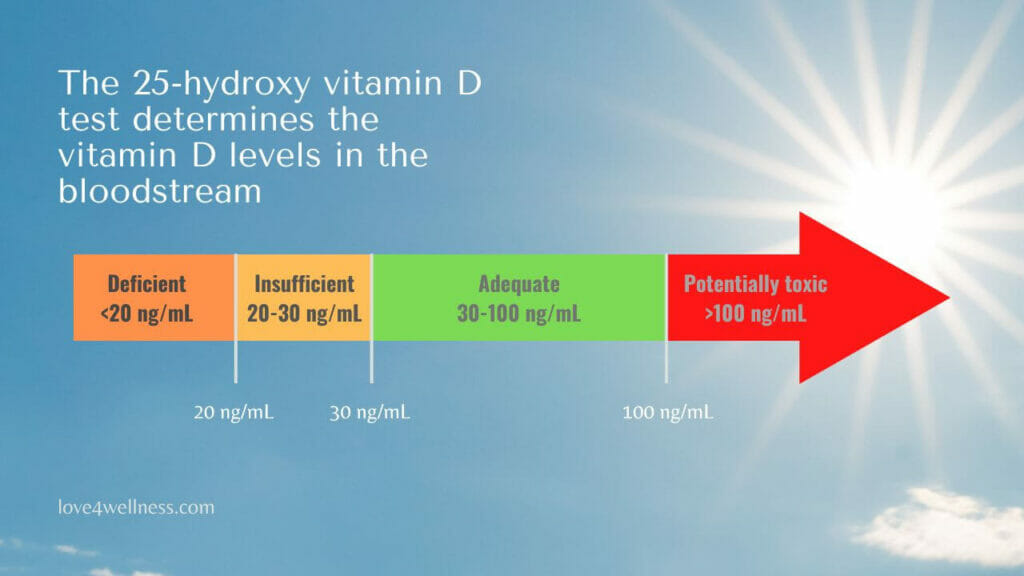The “sunshine vitamin” D, as with other nutrients, has its own bunch of functions. And so, with vitamin D deficiency, your body will have increased risk of health issues. This article is a comprehensive account of its uses, benefits, deficiency symptoms, sources, supplements, dosage, and toxicity of excessive amounts. So read on to know all about vitamin D.
What is vitamin D?
Vitamin D is a fat-soluble vitamin that plays a vital role in maintaining strong bones and teeth, as well as supporting immune function and overall health.
Vitamin D is a prohormone
Though discovered as a vitamin in the early 20th century, it is now recognised as a prohormone.
This is because it acts as a precursor to certain hormones and plays a role in many bodily functions.
The two forms
Vitamin D exists in two forms, D2 and D3. While plant-based sources contain vitamin D2, animal sources and sunlight provide vitamin D3.
How does your body process it?
The body cannot use vitamin D from sunlight or diet as such. Instead, both D2 and D3 are stored in fat cells and remain inactive until your body takes them and processes them for use. Through a process called Hydroxylation, both forms are converted into 25-hydroxy vitamin D2/D3 in the liver, which is then converted in the kidneys to the useful form called calcitriol.
Why do you need it?
Vitamin D is crucial for several important bodily functions. Some of the major reasons why it is important are:
- Bone health: The sunshine vitamin plays a crucial role in absorbing calcium from the intestines, essential for maintaining strong bones and teeth.
- Immune system function: It toughens the inflammatory response of some white cells and boosts the production of microbe-fighting proteins in immune cells. It promotes immune function and may reduce the risk of certain infections and autoimmune diseases.
- Interestingly, when the covid-19 pandemic hit the world, it was found that many affected were vitamin D Deficient! However, studies are insufficient to ascertain a link between vitamin D deficiency and testing positive for the virus.
- Cardiovascular health: It helps lower blood pressure and reduce the risk of heart disease.
- Cancer prevention: Some studies suggest that the vitamin may help to reduce the risk of certain types of cancer, such as breast and colon cancer. Further, studies have shown an inverse relationship between vitamin D levels and cancer mortality.
- Mood regulation: It plays a role in serotonin and melatonin regulation, thus affecting mood and sleep in people. Low levels have been linked to depression and other mood disorders.
- Hormone regulation: Your parathyroid hormones are produced when blood calcium levels are low. Since vitamin D is essential for calcium absorption, low levels can cause parathyroid to work more, resulting in hyperparathyroidism. Vitamin D deficiency may also lower estrogen levels, causing mood swings, hot flashes, etc., in reproductive women. Further, low levels of the vitamin may affect insulin sensitivity and insulin production.
Symptoms of vitamin D deficiency
When vitamin D levels are low, a person may experience symptoms such as bone pain and weakness, muscle weakness, and an increased risk of falls and fractures. In children, a deficiency can lead to rickets, a condition where the bones become soft and brittle. Long-term deficiency can also lead to osteoporosis, a condition where the bones become weak and brittle, increasing the risk of fractures.
Common symptoms include,
- Fatigue or tiredness
- Weakness or muscle pain
- Bone pain or weakness
- Depression or anxiety
- Impaired immune system
- Slow wound healing
- Hair loss
- Dry skin or eczema
- Dry eyes
- Frequent infections
- Delayed growth in children
You Might Also Like:
- 5 Useful Ways To Prevent & Manage Post Menopausal Osteoporosis
- 10 Lifestyle And Diet Tips To Manage Fibromyalgia Naturally
How to test?
A blood test (no fasting required) is done to test for vitamin D levels in your bloodstream. It tests for the 25-hydroxy vitamin D in the blood. While <20 ng/mL is insufficient, 30-100 ng/mL is considered adequate. Anything >100 ng/ml is potentially toxic to the body.
Who is at risk of deficiency?
While vitamin D deficiency can occur in anyone, certain groups of people are more at risk for deficiency.
- People with darker skin: Melanin, the pigment that gives skin its colour, reduces the skin’s ability to produce vitamin D from sunlight.
- Older adults: As people age, their skin becomes less efficient at producing vitamin D from sunlight.
- People who spend most of their time indoors: People who don’t spend much time outside, such as those who are institutionalised or who work indoors, are at risk of a deficiency.
- People with certain medical conditions: People with conditions that affect the skin’s ability to produce vitamin D from sunlight, such as eczema or psoriasis, are at risk of a deficiency. People with certain medical conditions, such as Crohn’s disease, inflammatory bowel disease or celiac disease, that affect the absorption of nutrients can also be deficient.
- People who are overweight or obese: It is a fat-soluble vitamin. Fat cells in obese people store the vitamin reducing its availability in the bloodstream.
- People who take certain medications: Some medications, such as glucocorticoids and anticonvulsants, can interfere with the body’s ability to absorb or use vitamin D.
- People with a low dietary intake of the vitamin: People who don’t eat enough vitamin D-rich foods, such as fatty fish, may be at risk of deficiency.
The more vitamin D, the better? No.
High levels of vitamin D can lead to a condition called hypervitaminosis D, which can cause symptoms such as nausea, vomiting, loss of appetite, weakness, and weight loss. It can also lead to high levels of calcium in the blood, which can cause damage to the kidneys and other organs.
Vitamin D toxicity can occur only with excessive doses of supplements and can never be from diet or exposure to sunlight.
Is it possible to get too much vitamin D from prolonged exposure to the sun?
No, getting too much vitamin D from prolonged sun exposure is impossible. It is generally safe to get vitamin D from sunlight, as the body can regulate its production of the vitamin. High levels are usually from taking supplements in high dosages.
Best sources of vitamin D
- Sunlight: The most natural source, of course, is the sun. The UVB rays from the sun turn a chemical (7-dehydrocholesterol) present on your skin into vitamin D3. However, dermatologists caution about the risk of skin cancer with increased exposure to the sun without protection, say, sunscreen or clothing. Also, there is increasing evidence that no matter how high the SPF of your sunscreen is, a certain amount of UVB rays reach your skin. And the risk of skin cancer weighs down the risk of vitamin D deficiency. So, it is safe to use sunscreen, probably with a lower SPF.
To get vitamin D effectively from sun exposure:
– Expose skin to direct sunlight for 10-15 minutes
– Exposure between 11 am and 3 pm is best when UVB rays are the strongest
– Go for a SPF 15 sunscreen during these 15 minutes as it may permit a decent amount of UVB absorption
- Fish: Fish such as salmon, herring, mackerel, and sardines are high in vitamin D.
- Eggs: Eggs are a good source, especially if the chickens are fed a diet enriched with the vitamin.
- Fortified foods: Many foods, such as milk, cereal, and orange juice, are fortified with vitamin D.
- Mushrooms: Certain types of mushrooms, such as shiitake and maitake can be a good source for vegetarians and vegans.
- Beef liver: Beef liver is also a good source.
- Cod liver oil: Cod liver oil is a traditional source of the vitamin and some people still use it today.
When deficient, is it safe to take supplements?
The supplements can be beneficial for people with a deficiency, those with certain medical conditions, and those who are at risk of deficiency due to lifestyle factors such as living in northern latitudes or spending most of their time indoors.
However, high doses of vitamin D can be harmful. So it’s important to speak with a healthcare professional before starting a supplement regimen. Excessive intake can lead to symptoms such as nausea, vomiting, constipation, and weakness. Some studies have also suggested that high doses may increase the risk of certain cancers, so it is important to be cautious and consult with a healthcare professional.
Supplement dosage and when to take
There are two main forms of vitamin D supplements: D2 and D3. D3 is the more effective form of vitamin D and is often recommended by healthcare professionals. It is typically derived from animal sources, such as lanolin, while D2 is derived from plant sources, such as mushrooms.
The supplements are available in various forms, including capsules, tablets, and liquids. They are also available in different strengths, the most common being 400IU, 800IU, and 1000IU. The recommended daily amount for adults is 600-800 IU. But it can vary depending on age, sex, and health status.
The supplements are typically taken once a day, and it is best to take them with food to help absorption. Also, vitamin D is fat-soluble, which means it does not dissolve in water. Hence, the absorption into the bloodstream is better when consumed with a fat source, such as a spoonful of oil or a small amount of cheese.
A word from Love4wellness
Overall, vitamin D is an essential nutrient that plays a vital role in maintaining strong bones and teeth. Further, as a prohormone, it has a significant role in various bodily processes and in supporting overall health.
Interestingly, many healthy adults with insufficient levels, say 15 ng/mL, do not experience any symptoms and are perfectly fine. However, those at risk for a deficiency and those experiencing any symptoms should consider taking vitamin D supplements under the guidance of a healthcare provider.
Nevertheless, it is important to remember that getting the vitamin from natural sources, such as sunlight and food, is the best way to ensure adequate intake and avoid the potential risks associated with taking supplements.
So don’t miss out on vitamin D. Wear your wide-brimmed hats, roll up your sleeves, and get some sunshine every day between 11 am and 2 pm!
Images: canva.com

